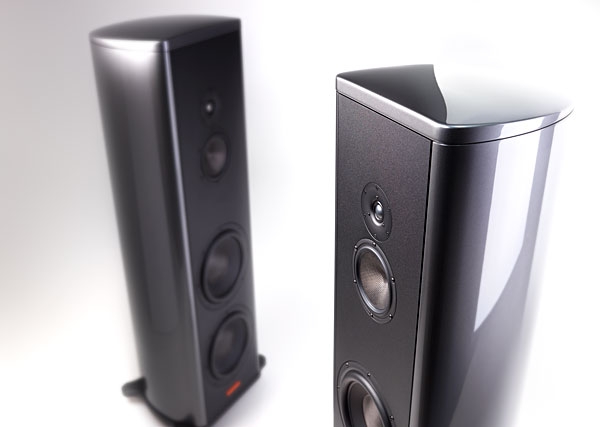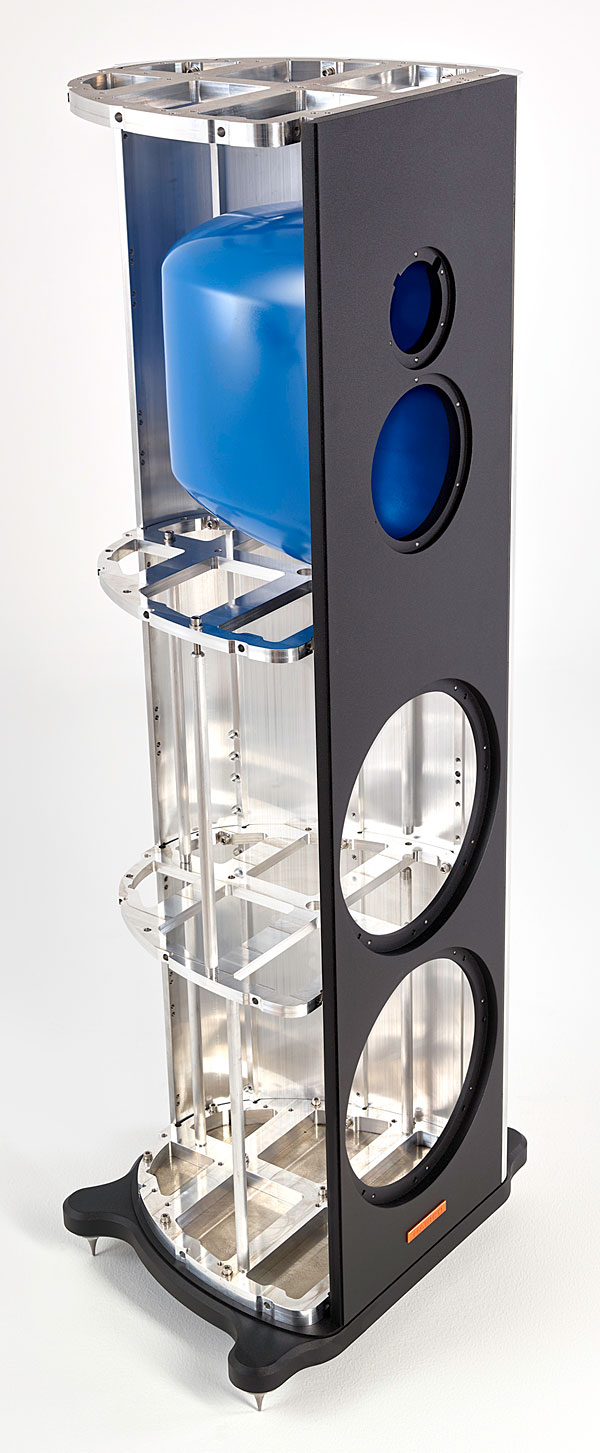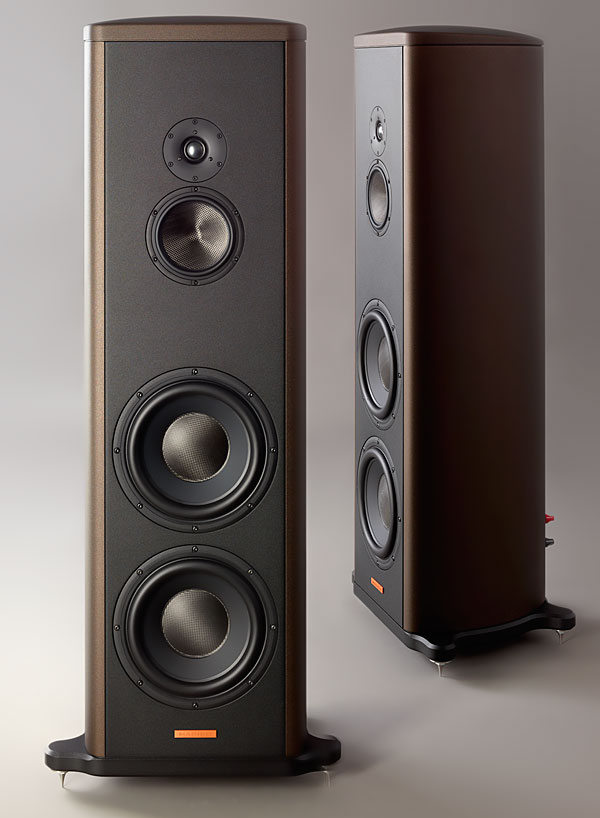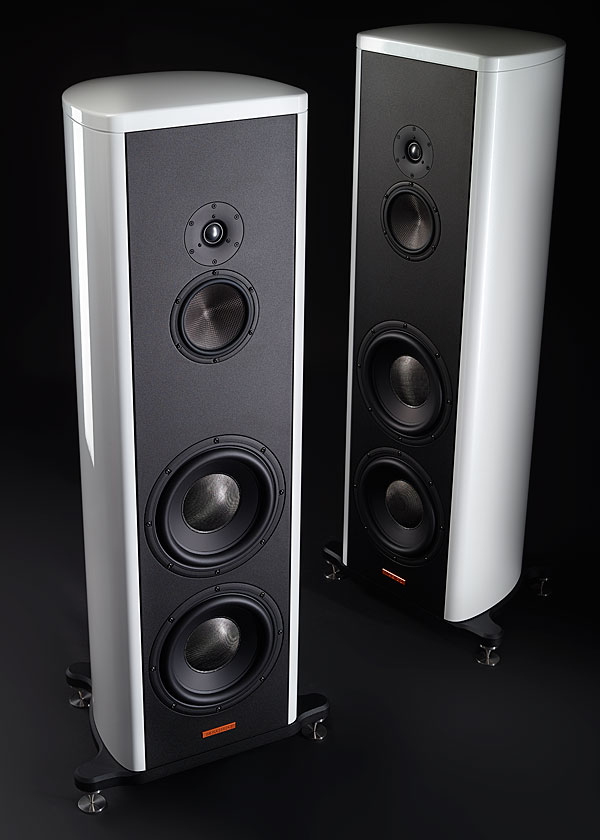
Like the original S5, the S5 Mk.II is a three-way, floorstanding design, 4′ tall. The twin, sealed-box–loaded, 10″ aluminum-cone woofers with substantial rubber roll surrounds, 6″ midrange unit with a graphene-coated Nano-Tec cone, and 1.1″ diamond-coated, beryllium-dome tweeter are mounted vertically in line on its black front baffle. (Nano-Tec is Magico’s name for a sandwich of Rohacell, a foam composite material extensively used in the aerospace industry, and external layers of carbon fiber coated with layers of carbon nanotubes.)The Magico’s internally braced enclosure is constructed from an aluminum extrusion 1?2″ thick and 16″ in diameter, with the midrange unit loaded by a subenclosure made of a proprietary polymer. The top cap is machined into complex shapes, both over and under, to minimize external diffraction and internal standing waves, while the bottom plate includes outriggers at its four corners into which can be screwed heavy-duty spikes. (As supplied, sturdy wheels are screwed into the outriggers to make handling easier.) Electrical connection is via a pair of binding posts at the bottom of the rear panel.The S5 Mk.II is available in two different finishes. With the first, called by Magico M-Cast, the speaker costs $38,000/pair. In the handsome high-gloss M-Coat finish of the review samples, the price is $42,750/pair.Diamond–Nano-Tec–Graphene
It is its drive-units that distinguish the Mk.II S5 from its predecessor. As Yair Tammam lives and breathes drive-units, I asked him about the changes, particularly that new 26mm-diameter tweeter, which has a 40µm-thick beryllium dome coated with a 5µm-thick layer of pure diamond, and was developed from the 28mm dome first seen in Magico’s statement M-Project speaker.
The first Magico speaker reviewed in Stereophile, the V3, in May 2008, used a high-performance ring-radiator tweeter, but Tammam was bothered by the fact that such a tweeter’s diaphragm operates in breakup mode in the upper region of its passband—he wanted a diaphragm that operated as a perfect piston throughout its operating bandwidth. A beryllium dome is both light enough and stiff enough to behave pistonically, and was used in the Magico Q5, which Michael Fremer reviewed in November 2012. Applying a layer of diamond to the metal, Tammam explained, results in a dome with a more homogeneous surface, which both reduces intermodulation distortion and results in a more benign harmonic-distortion signature that is less like that of a metal dome. I asked why they hadn’t gone all the way and used an all-diamond diaphragm. It turned out that, yes, diamond would produce a very stiff diaphragm, but the required suspension would raise the tweeter’s low-frequency resonance from the desired 500Hz or so to about 1.3kHz. This, in turn, would mean that the tweeter would have to be crossed over to the midrange drive-unit at too high a frequency. Beryllium’s lower mass ensures that the resonance frequency is close to 500Hz, but the diamond layer raises the dome’s stiffness to extend the high frequencies.

I asked about the Nano-Tec cone used in the midrange unit. Tammam explained that in the earlier versions of this sandwich cone, the inner layer was stiffer than the outer layers, to match the voice-coil former. There followed changes in the former material and the thicknesses of the layers, guided by finite element analysis (FEA), until, in 2014, a Japanese corporation developed a way of laying down the carbon fibers in the weave that resulted in a more even flow of the resin before the material was cured in an oven. This seventh-generation version of Magico’s driver has a cone that contains 30% less resin in the carbon-fiber layers, but one that is 300% stiffer.
In Magico’s prior midrange cone the front layer of carbon fibers was overlaid with carbon nanotubes, but the US company that produced the nanotubes came up with a way of coating the front of the carbon-fiber layer with a skin of graphene, a superstiff sheet of carbon just one atom thick.
It’s desirable that a speaker cone be of varying thickness: thickest at the center and the boundary with the voice-coil former, thinnest at the junction with the surround. However, Magico used to use a sandwich core of constant thickness, because the foam material would fracture if the thickness varied. For their new generation of midrange units they developed a process in which the foam is carefully injected between the front and back carbon-fiber, to permit the overall thickness to vary in the desired manner.
Tammam told me that they made much use of the Klippel analysis system in the development of the S5 Mk.II’s drive-units, particularly regarding the spider, to get a significantly greater linear cone excursion. Computer simulation of the driver as a complete system—cone, surround, spider, motor, and magnetic circuit—allowed them to produce a drive-unit that combined the best technologies currently available to give performance that doesn’t significantly change with the rise in temperature that typically occurs after a couple of hours of operation.
Yair Tammam summed up his goals in drive-unit design as achieving linearity not just with large excursions but with very small movements, so that the speaker’s character remains the same at low sound-pressure levels as it does at high SPLs.
Listening
After Mackay and Tammam had used the excellent Dayton OmniMic v2 system to position the S5 Mk.IIs in my room and declared themselves content, they left for home. The speakers’ front baffles were about 80″ from the wall behind them and 98″ from my listening position; the left speaker was 38″ from the closest sidewall, the right 48″ from its sidewall. I settled down for some critical listening, beginning with the PS Audio DirectStream DAC (Yale operating system, which I prefer to the earlier Pikes Peak) directly feeding my Pass Labs XA60.5 monoblocks, and the Magicos hooked up to the Passes with Kubala-Sosna Elation! cables.
The low-frequency, 1/3-octave warble tones on my Editor’s Choice (ALAC file ripped from CD, Stereophile STPH016-2) played cleanly down to 25Hz, with the 32Hz tone not exciting the lowest-frequency mode in my room as is usually the case. Although the 20Hz tone seemed quieter than those immediately above it, the Studio Six SPL meter app on my iPhone, used with Studio Six’s iTestMic, registered it as being equally loud. That it seemed quieter was due not only to my reduced hearing sensitivity in the very low bass, but also to the fact that distortion, which would produce harmonics that would be more audible, must be low in level.

